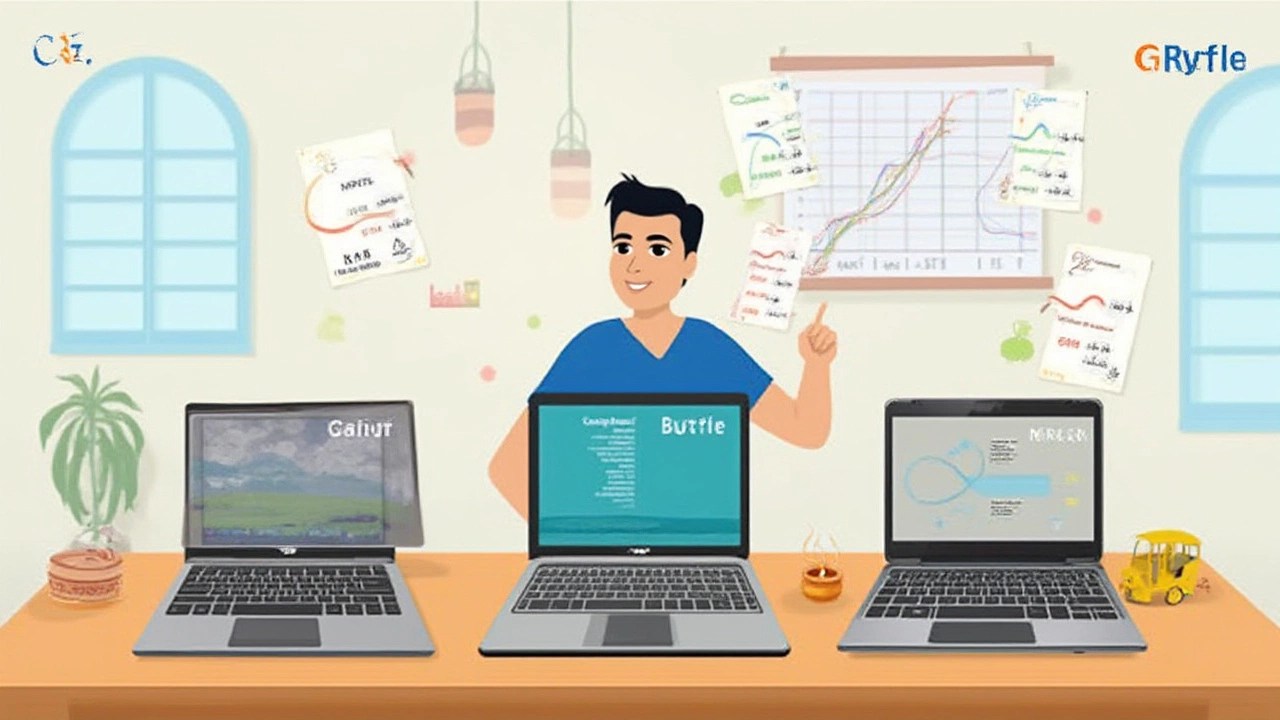
What do you call a 3D modeler with a laggy laptop? Unemployed. That’s not far from the truth if you’re an engineering student and your laptop keeps freezing during a project. These days, engineering software eats RAM for breakfast. You absolutely need firepower, or you’ll spend way more time waiting for simulations to run than actually learning complex concepts. Everyone keeps talking about "powerful laptops"—but what does that mean for you in 2025? Laptops have gotten lighter, faster, and sometimes ridiculously expensive. Then there’s battery life, port selection, and whether you want a touchscreen you’ll actually use. Picking the best laptop is more than comparing price tags or brand names. It can make or break your college experience—and honestly, your sanity.
Understanding What Engineering Students Need in a Laptop
Every engineering discipline throws its own set of curveballs. Mechanical engineers sweat over SolidWorks. Civil engineers rely on AutoCAD. Electrical engineers might live inside MATLAB or Simulink on long nights. If you’re studying computer engineering, you’ll probably need to run Linux in a VM at least once. That’s just the start—don’t forget your lectures, group assignments, and a dozen Chrome tabs eating up memory.
Let’s pin down the core specs you should look for in a laptop for engineering. Top of the list is a strong processor—with Intel’s latest 14th Gen or AMD’s Ryzen 7000 series being the go-to in 2025. Look for at least a 6-core CPU (8+ is better). Next, RAM. 16GB is minimum, 32GB if you don’t want to pray every time you open Autodesk. For storage, SSD beats HDD every time. 512GB is okay for most, but 1TB means you won’t need to delete old projects before finals. Faster SSDs also help big files load quickly.
Graphics aren’t just for gaming. If you use 3D modeling or simulation software, dedicated GPUs are a must. NVIDIA’s RTX 4000 series and the newest Radeon chips crush rendering tasks and simulations. If you’re mostly coding, integrated graphics are fine, but if you ever touch CAD, step it up. Screen size can get sticky. Some say go for portability with a 14-inch, but that’s rough for design work. A 15.6-inch or 16-inch screen with at least Full HD (or better, 2.5K or 4K) gives your eyes a break and makes multitasking easier. Also, look for good color accuracy—helpful for clear diagrams and PDFs.
Batteries are bigger now, but heavy-duty processors and GPUs burn through them fast. Six hours unplugged is decent, but docking with USB-C power is even better. Finally, you need ports—lots of them. USB-A (for legacy gear), USB-C/Thunderbolt (for fast transfers and docking), HDMI (presentations), and SD card slots (handy for fieldwork). And yes, these little things matter. One of the more annoying things in 2025 is how many slim laptops ditch useful ports—don’t fall for it unless you’re happy carrying dongles everywhere.
Top Laptop Models for Engineering Students in 2025
Let’s talk actual laptops, not just specs on spreadsheets. Right now, the best laptops for engineering students are a mix of beefy power, practical portability, and staying under (or at least near) a realistic student budget. You’re probably not looking to drop $4,000 on a pro workstation (unless your rich uncle is throwing cash around). So I’m skipping those overkill models and focusing on real-world recommendations.
Here’s a quick breakdown of 2025’s hot picks, with ballpark prices and their biggest pros/cons:
| Model | CPU | GPU | RAM | Storage | Screen | Approx. Price (USD) |
|---|---|---|---|---|---|---|
| Dell XPS 15 (2025) | Intel i7-14700H | NVIDIA RTX 4060 | 16/32GB | 1TB SSD | 15.6” OLED FHD+ | 1800 |
| Lenovo Legion 5 Pro (2025) | AMD Ryzen 9 7845HS | RTX 4070 | 32GB | 1TB SSD | 16” 2560x1600 | 1700 |
| MacBook Pro 14 (M4, 2025) | Apple M4 | Integrated (very fast) | 16GB | 512GB SSD | 14.2” Liquid Retina XDR | 2000 |
| HP Envy 16 (2025) | Intel i7-14700H | RTX 4050 | 16GB | 1TB SSD | 16” 2.5K | 1400 |
| Acer Predator Helios Neo 16 | Intel i7-14700HX | RTX 4060 | 16GB | 1TB SSD | 16” FHD+ | 1600 |
| ASUS ROG Zephyrus G14 (2025) | AMD Ryzen 9 7940HS | RTX 4060 | 32GB | 1TB SSD | 14” 2560x1600 | 1900 |
Dell’s XPS 15 and the Lenovo Legion 5 Pro dominate because they blend pro-level performance with surprisingly good portability. The MacBook Pro is a rising star, especially since Apple’s silicon now handles MATLAB, CAD, and simulation software shockingly well—and it gets monstrous battery life, often hitting 14 hours in real use. That said, some rare specialized engineering apps still run better natively on Windows (like certain plugins for SolidWorks).
The HP Envy line is great for the money, packing serious specs and a color-rich screen, but a slightly bulkier design. Acer’s Predator series is technically a gaming laptop, but don’t snub it—all that power under the hood makes it a killer budget pick for heavy-duty software. ASUS’ Zephyrus G14 is for those who want ultralight with muscle, though you’ll pay a bit more for the privilege.
Don’t get too hung up on small differences in RAM or SSD size, since both can often be upgraded. What matters: strong CPU, solid GPU, and a screen that won’t make your eyes scream by midterms. If you go Mac, double-check compatibility for all your must-use engineering programs. And don’t ignore warranty and after-sales support—accidents happen more than you’d think (one survey of US students found that 38% have had a laptop mishap in college).

Windows, Mac, or Linux: Which OS Is Best for Engineering?
Ever had a friend try to convince you MacBooks are “just for creatives”? Or that real engineers only use Linux? The truth’s less dramatic. Most engineering software—AutoCAD, MATLAB, SolidWorks, ANSYS, Revit, Rhino, and the like—still favors Windows, but that’s changing because developers are making more tools cross-platform. Windows 11 is a safe bet for full compatibility: it just works with nearly everything you’ll meet as an engineering student.
Apple’s new M4 MacBooks are wild cards. Their chips are super efficient and knock out many workflow tasks thanks to unified memory and speedy SSDs. For civil or mechanical engineering, though, certain core apps don’t run natively. You might have to use Parallels Desktop or CrossOver to run Windows programs—which does work, but you’ll want that extra RAM if you go this route.
The old stereotype that “Linux is just for hackers” is fading. Any computer engineering or software-heavy student will probably tinker with Linux, maybe for embedded systems or advanced networking. Windows WSL (Windows Subsystem for Linux) lets you run many Linux tools inside Windows, which is crazy useful now. Still, for core day-to-day stuff, you want either Windows (mainly) or Mac (if you value the battery life and just need code or simulations).
If you’re doing any 3D modeling with dedicated plugins, double-check that your laptop’s OS is fully supported. Annoying workarounds can eat up hours you don’t have, especially during crunch weeks. Quick pro tip: some colleges hand out student licenses for software only available on one OS, so always check your department’s official recommendations before buying.
Budget Tips—Getting the Best Value for Your Money
Laptops for engineering aren’t cheap. But you don’t need to empty your bank account (or take out another loan) if you’re strategic. Start by timing your purchase—big back-to-school deals in July and August, and then again on Black Friday/Cyber Monday in November, are usually the best bets to snag discounts. Many stores also give student discounts if you register with your .edu email, so definitely take advantage of that.
Don’t overpay for stuff you won’t use. Super-high refresh rate screens are great for gaming but mean nothing for simulations or coding. Touchscreens are handy for drawing diagrams but rarely needed unless you’re big into design courses. And remember, most RAM and storage can be upgraded later. Focus first on the best CPU and GPU you can afford—they’re the only bits you can’t swap out easily (if at all).
If your budget’s tight, don’t buy used laptops unless you know the seller—it’s too easy to get stuck with hidden issues that’ll ruin your semester. Certified refurbished direct from the manufacturer is a safer bet. Also, most major brands now offer accidental damage protection (sometimes just $50-100 extra). Seriously consider it—spilled coffee or one missed backpack zipper can literally end your semester if you’re not covered.
Here’s a major hack: keep an eye out for last year’s flagship models when new releases drop in August/September. You’ll often find the “old” (but still super fast) models heavily discounted while everyone’s drooling over the new chipset. You can save hundreds this way and still have a laptop that chews through engineering software without breaking a sweat.

Maximizing Battery Life and Portability in Daily Student Life
You know what the real engineering challenge is? Making it through a 10-hour day without finding a power outlet. It’s 2025, and battery life isn’t quite where we want it, especially if you have a machine built for heavy software. You can still game the system, though. First, pick a model with fast charging—most high-end laptops now let you boost 50% battery in 30 minutes. Super handy between classes. Also, always adjust your power mode for what you’re doing; plenty of tools let you quickly toggle CPU/GPU performance, so you don’t waste battery during lectures or casual web browsing.
Weight and build matter as well. Tossing a 6-pound slab in your backpack every day gets old fast. Most of today’s 15–16-inch engineering laptops land around 4–5 pounds, but there are lighter options like the Zephyrus G14. If you bike to campus or walk long distances, those pounds add up. The new crop of higher-res screens with anti-glare coatings also means you can work longer without eye strain, even in sunlit labs.
Hot tip for the perpetually mobile: invest in a compact, 65W+ USB-C portable charger that matches your laptop’s requirements. Forgetting your charger at home is no longer a day-ruiner if you’ve got one in your bag. Also, snag a good laptop sleeve with true shock absorption—you’d be amazed at how many warranties won’t cover drops or cracked screens.
If cloud storage isn’t built-in, grab at least 100GB on Google Drive or OneDrive for regular backups. One accidental delete, and you’ll thank yourself later—stats say nearly 60% of college students lose digital files at least once during their degree. And remember, portability doesn’t just mean weight—it means how easy the laptop is to plug in, back up, and carry around safely every single day.